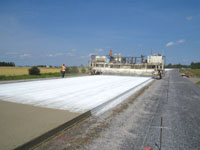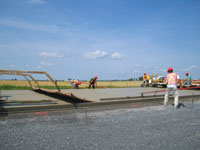
The Ready Mixed Concrete Association of Ontario (RMCAO) is pushing hard
for more concrete on Ontario highways, but the Ministry of
Transportation (MTO) is standing firmly behind its decision-making
process on the cost-effective use of concrete or asphalt for roads with
differing traffic volumes.
Could more concrete be used on Ontario’s secondary highways? Some say yes, but the provincial government says traffic volumes do not warrant its use.
The Ready Mixed Concrete Association of Ontario (RMCAO) is pushing hard for more concrete on Ontario highways, but the Ministry of Transportation (MTO) is standing firmly behind its decision-making process on the cost-effective use of concrete or asphalt for roads with differing traffic volumes.
Since 2001, MTO has awarded nine alternative bid contracts, and the concrete bid has been successful each time, says MTO spokesperson Bob Nichols. This includes two recent concrete pavement contracts carried out on Highway 3 near Leamington, an arterial highway.
 |
| A stretch of Ontario Highway 410 in the Brampton, Ont., area showcases concrete on the main highway and asphalt on the entrance ramp. (Photo courtesy of the Ready Mixed Concrete Association of Ontario) |
While RMCAO President John Hull is pleased the MTO includes concrete alternative designs in its tendering process for 400 series highways, he would like to see MTO requesting alternative bids on all arterial and collector classifications of roads instead of just calling for “asphalt only.”
Hull says CANPav™, a web portal software program developed by RMCAO over the last two years (see sidebar), has shown that concrete consistently provides considerably less first costs than asphalt, and provides even more cost savings when life-cycle costs are analyzed. “The numbers are based on design and materials cost inputs provided by municipalities and validated by three major Ontario roadbuilders,” he notes. “All costs and designs are entered by the user, and as there has never been a tool like this before – people have a new understanding of the realities now available to them.”
However, Nichols disputes RMCAO’s first costs claim about cement. He says that although concrete pavement is very cost competitive on heavily trafficked freeways, where the alternative asphalt design is thick, MTO analysis shows that it would be difficult for concrete to compete against the much thinner asphalt designs typically found on lower traffic, secondary highways. “MTO cost information shows that concrete would not be cost-competitive against a typical flexible pavement rehabilitation for a lower volume road with only 90 to 150 mm of asphalt,” he notes. Nichols does admit, however, that higher volume roads, particularly roads with heavy trucks, require thicker pavement structures. “With increasing asphalt prices, a thick asphalt pavement design may have higher life-cycle costs than a concrete pavement,” he says.
“The cost of liquid asphalt increased 251% between July 2003 and July 2008 and is extremely volatile,” says Sherry Sullivan, an RMCAO engineer. She adds “The per cent change in cost from a year ago was 14.4 for asphalt and only just 0.6 for concrete. In September 2010, the asphalt price index increased by 8.3% and the concrete price index has remained fairly consistent with a mere 0.2% increase. Concrete continues to be economically stable.”
 |
|
| A stretch of concrete highway being constructed on Ontario Highway 417 near Ottawa. (Photo courtesy of the Ready Mixed Concrete Association of Ontario) |
It is MTO practice to evaluate at least three pavement design options for each project and compare life-cycle costs of these options before deciding on the selected pavement design. “Traffic staging, need for road closures, detours or alternative routes, and access issues may preclude selection of a concrete pavement design,” says Nichols. Other factors MTO considers when evaluating pavement options include concrete curing times and grade raises.
Nichols says the MTO believes that both road materials are suitable for use in highway construction: “MTO will be continuing to work with both industries to ensure that the Ministry’s pavement selection policy reflects the advantages of both concrete and asphalt pavements, by using each where they are most cost-effective based on life-cycle costing analysis.”
Greener Alternative
First costs and life-cycle costs aside, Hull says there are other costs to be considered when choosing surface options – which also impact on the environment. He points to research completed by Canada’s National Research Council (NRC) that shows fuel savings result on concrete pavements with heavy trucks. “These fuel savings and the resulting reductions in CO2 and other vehicle emissions are possible because concrete has less rolling resistance than asphalt,” he says. “It takes less fuel to go the same distance.”
Nichols says the NRC study reported a fuel savings of only about four per cent. “It has been pointed out that the testing had several limitations,” he adds. These include small sampling size and different pavement grade conditions between Hwy 417 and Hwy 440 test areas. “Factors such as ambient temperature, wind resistance, and surface roughness are also considered to have had a bearing on fuel consumption,” he asserts
 |
|
| Putting the finishing touches on Highway 417 near Ottawa. (Photo courtesy of the Ready Mixed Concrete Association of Ontario) |
The conclusions of earlier research conducted in Europe also challenge the findings of the NRC study. “Netherlands Pavement Consultants of Holland made theoretical calculations of the maximum energy dissipation when driving on flexible asphalt pavement and when driving on rigid cement concrete, using the programme VEROAD® developed at Delft University of Technology,” Nichols says. “The conclusion of [their] report is that on a yearly average, it is estimated that less than 0.05% extra fuel consumption may exist for trucks driving on asphalt pavements.” In addition, a study conducted by the Swedish Road and Traffic Research Institute concluded there was no significant difference for passenger car fuel consumption between asphalt and cement concrete road surfaces.
Nichols goes further. “Recently…internationally recognized expert on rolling resistance Ulf Sandberg concluded, as part of a presentation at Transportation Research Board in January 2009, that there is “no indication that cement concrete gives lower rolling resistance than asphalt.’”
Hull’s other green claim about concrete relates to the fact that over 50% of Canada’s crude oil required for asphalt is imported. “Portland cement has less environmental impact,” he says, “because it’s manufactured from local limestone.” Nichols agrees with Hull’s statistic about asphalt and that Portland cement is manufactured from local materials but adds “Canada is both an exporter and an importer of crude oil, with over half of production going to the United States; imported oil typically feeds refineries in Eastern Canada.” He says it should also be kept in mind that asphalt cement and Portland cement represent a relatively small proportion of both hot mix and concrete. “Aggregates from local sources make up the major proportion of both,” Nichols stresses. “Hot mix typically contains only about 5% asphalt cement by weight.”
| CANPav™ software CANPav™ was designed by the Ready Mixed Concrete Association of Ontario (RMCAO) after extensive consultations with major roadbuilders. The modelling tool “quickly determines the cost advantages of using concrete as the paving material of choice for municipal streets and roads and commercial parking lots. CANPav is unique because the user has complete control over the concrete and asphalt cross sections and the material cost inputs. PDF summaries of your cost comparisons can be saved and printed. CANPav also gives you online access to StreetPave software program for concrete roads and considers the cost effects of future maintenance activities.” |
Ian Pilkington, the chief geotechnical, materials and pavement engineer at B.C.’s Ministry of Transportation and Infrastructure, also questions how much greener concrete roadway construction is over asphalt roadway construction. “The production of cement creates a significant amount of greenhouse gases,” he says. Pilkington adds that “the statement that ‘over 50% of Canada’s crude oil (required for asphalt) is imported’ is actually not true for us out here in the west. The western provinces receive almost all of our asphalt oil from Cold Lake, Alta., a very good source of high quality crude.”
Currently no concrete is used on major highways or secondary roads in B.C and the reason is similar to that given by the MTO. “Through our analysis of costs of road construction versus longevity (how long the road lasts before it needs to be rehabilitated), we have found that asphalt pavement still provides a better life-cycle cost than concrete,” says Pilkington. “The reason for this is due to the relatively low traffic volumes that we have in this province compared to other jurisdictions like Ontario, Quebec and many of the U.S. states where concrete has been found to be a viable pavement alternative.”
However, all Public-Private-Partnership projects underway in B.C. were given the option to consider using concrete as a pavement alternative to asphalt. Although none of these P3 projects have gone with concrete, Pilkington says, “It should also be noted that we do use concrete in areas where we have high truck loads under static or slow moving conditions with tight turns required, areas such as bus stops, weigh scales and border crossings.”
Regarding the future use of concrete in roadways in B.C., Pilkington says cost per kilometre of concrete paving will have to get closer to that of asphalt paving and/or traffic volumes will have to increase to a point where the life-cycle costs will make concrete roads more favourable, or at least comparable, to asphalt.
“Here in B.C., we do recycle a significant amount of asphalt,” he adds. “We have worked with industry to develop and refine a technique known as Hot-in-Place Recycling (HIP or HIPR), in which the entire asphalt roadway is recycled during the HIP process with only 20% of virgin asphalt added into the process to increase the durability of the product.” The new rehabilitated HIP road consists of 80% recycled asphalt and 20% new, and approximately 30% of annual rehabilitation is done using this technique.
“We have also changed our internal policy so that all millings created from removing old asphalt cannot be stockpiled or placed in our gravel pit or yards anymore, a common practice in the past that created large piles of old asphalt all over the province,” says Pilkington. “Now, any millings are either used to pave side roads, mixed in with shouldering gravel to create stronger shoulders, given to the contractor to dispose of at their cost (in which case, they in turn usually find a business or home-owners that would like their driveways or parking lots paved at an economical price) or mix the millings (known as Recycled Asphalt Pavement, or RAP) in with the new asphalt.” British Columbia has also just increased the allowable percentages of RAP in new pavement, with up to 100% RAP allowed on the bottom lift of secondary highways and up to 35% in the top lift on secondary highways.
Clearly, there is room for both road construction methods and there are definitive advantages to each. For anyone involved in the roadbuilding industry, itʼs a debate worth watching.
Print this page